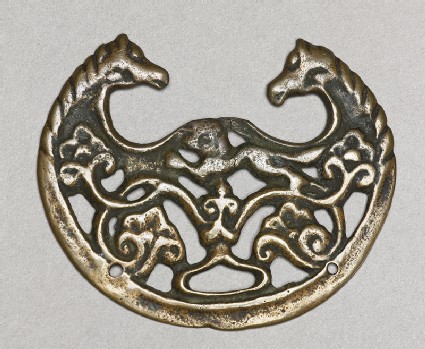Browse: 105 objects
- Reference URL
Actions
Talismanic plaque, or tokcha, with confronted horses
-
Details
- Associated place
- Date
- 8th - 9th century AD (AD 701 - 900)
- Material and technique
- brass
- Dimensions
-
0.3 cm (height)
8.2 cm (diameter)
- Material index
-
processed material › metal › alloy › copper alloy › brass
- Technique index
- Object type index
- No. of items
- 1
- Credit line
- Purchased, 2001.
- Accession no.
- EA2001.154
-
Further reading
Heller, Amy, Early Himalayan Art (Oxford: Ashmolean Museum, 2008), no. 28 on p. 98, illus. p. 99
Location
Objects are sometimes moved to a different location. Our object location data is usually updated on a monthly basis. Contact the Jameel Study Centre if you are planning to visit the museum to see a particular object on display, or would like to arrange an appointment to see an object in our reserve collections.
Publications online
-

Early Himalayan Art
This appears to be a tokcha used as a belt buckle or as a medallion in a set of horse trappings. The horse heads are confronted. Their manes are rendered as diagonal incised lines within a rounded edge. This marks the transition from the raised design to the narrow flat rim, which has two drilled holes and a carved slot through which strings or leather bands might pass. The horse heads are shown in three-quarter view, with both eyes carved. The bodies of the horses are only suggested as far as the base of the neck, at which point small florets and stems form interlocking curves. At the centre appears a rampant lion with a full mane; the use of a strap over the lion's head has worn away much of the mane, which is now cracked. The tail is long and full, with tufts rather like a yak tail. The lion extends his legs over the vine tendrils which link four distinct blossoms, two on either side, all emerging from the carved slot at the centre of the bottom edge of the curved rim.
The importance of the horse in pre-Buddhist Tibetan religious customs is well known [1]. Notably, the Tibetan Royal Chronicle describes horse sacrifice as part of the burial rites for the most important ministers, which has been confirmed by recent archaeology [2]. The practice of these burial rituals decreased as Buddhism progressively took root in Tibet. During the same period, the lion lost its symbolic association with the might of the Tibetan sovereign, as Tibetan liturgies and artists progressively emphasized lions in a purely Buddhist context as the emblem of Sakyamuni and Vairocana [3]. The horse as a Buddhist symbol, the precious steed who represents the mobility and speed of the cakravartin, is always represented with jewels on the body or head [4]. These factors suggest a date for this tokcha prior to the second diffusion of Buddhism in Tibet which began in the mid-tenth century.
[Footnotes:]
1 See Heller, 'Archeological Artefacts from the Tibetan Empire in Central Asia', for discussion of the role of the horse and horse-shaped artefacts in ancient Tibetan burial practices.
2 Burial rituals including horse sacrifice are described in c. ninth-century Tibetan manuscripts from Dunhuang studied by Haarh, The Yar-lun Dynasty; Lalou, 'Rituel bon-po des funerailles royales'; and Stein, 'Un document ancien relatif aux rites funeraires des bon-po tibetains'.
3 Snellgrove, The Image of the Buddha, pls. 257-9.
4 Dagyab, Buddhist Symbols, p. 77.
Galleries
© 2013 University of Oxford - Ashmolean Museum




